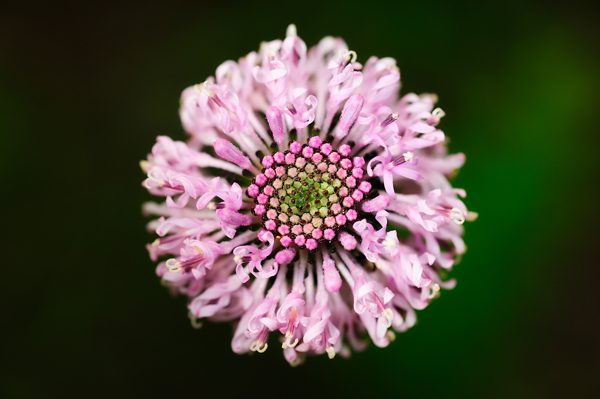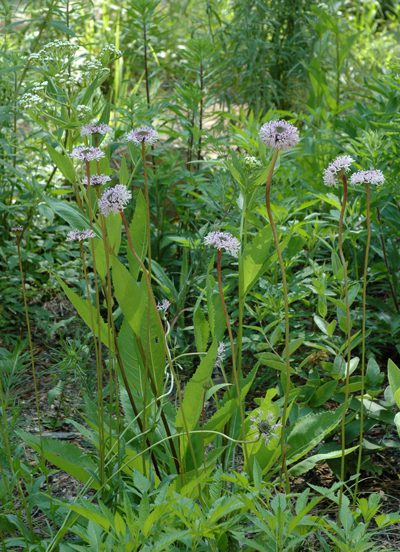New plant in the Piedmont – the Tall Marshallia

The discovery of a new species conjures images of explorers in pith helmets hacking through remote regions of the Amazon and stumbling across something outlandish. The reality is generally much less dramatic. New species can still be found in our own backyards, even in the well-trod Piedmont. According to Alan Weakley, director of the Herbarium at the North Carolina Botanical Garden, 400 plant species have been discovered in the Southeast since 1960. One of the most recent is Tall Marshallia (Marshalli legrandii).
This rare species is similar to the more common Barbara’s Buttons (Marshalli obovata var. obovata) which is found throughout the Piedmont and Southern coastal plain along roadsides and in open habitat like pine woods and oak savannas. The plant is named for its white to pale pink button-shaped buds which open to lacy flowers in April and May. Their delicate appearance belies a rugged constitution. The NCBG chose this drought-resistant darling as its Wildflower of the Year in 2009.
 Weakley named the new species to honor Harry LeGrand Jr., the man who first noted the attributes that distinguish Tall Marshallia from Barbara’s Buttons. The Latin name also works on a descriptive level. The new species is indeed grand. It’s taller than Barbara’s Buttons and has a larger flower head. The flowers are a deeper pink and appear a bit later, generally in June and July.
Weakley named the new species to honor Harry LeGrand Jr., the man who first noted the attributes that distinguish Tall Marshallia from Barbara’s Buttons. The Latin name also works on a descriptive level. The new species is indeed grand. It’s taller than Barbara’s Buttons and has a larger flower head. The flowers are a deeper pink and appear a bit later, generally in June and July.
Tall Marshallia is also restricted to a special habitat known as a diabase glade or barren. Diabase is a hard and dense volcanic rock that resists erosion. When covered by a thin layer of clay, this hardpan creates a natural community inhospitable to trees, something unusual in our region. Historically, natural disturbances such as fire and grazing herbivores also suppressed the trees. LeGrand first documented Tall Marshallia at a site in Granville County that is perhaps the best example of this natural community in the state. The plant has been found at only a handful of similar sites in North Carolina and Virginia. Two of those local populations have since disappeared.
This unique habitat has long been of interest to LeGrand. Something of a renaissance man, LeGrand (who holds a Ph.D.) is a vertebrate zoologist by training – a discipline which focuses on any animal with a backbone such as fish, amphibians, reptiles, mammals and birds – but he’s also an expert on butterflies, dragonflies, damselflies and plants. During his 28-year career with the N.C. Natural Heritage Program, he has been instrumental in documenting and protecting habitats across our state, but he has always maintained a special interest in the Piedmont. His field work has included stints in the Uwharries, which Weakley lauds as having some of the best biodiversity in the entire Piedmont – not just in the state, but in the entire eco-region extending from Virginia to Alabama.
Finding a specimen in the field is merely the beginning of the long and sometimes arduous process required to name a new species. Scientists first consider morphological features. Does the plant look different? Does it grow in a different habitat or geographical area? Does it bloom at a different time, making cross-pollination impossible? Sometimes they go on to sequence the plant’s DNA and test for genetic differences. To complete the process, findings must be published in an academic journal, giving other scientists the opportunity to evaluate and comment on the hypothesis. In the case of Tall Marshallia, Weakley, whose Ph.D. studies were in botany, felt the morphological differences provided enough evidence to justify naming a new species. One of his colleagues at Auburn University is going ahead with genetic testing as well.
To see Tall Marshallia in bloom this season, visit the NCBG’s Piedmont Display Garden in the coming weeks. Scroll below to see a photo of the plant in the garden.
Special thanks to Laura Cotterman and Alan Weakley of the N.C. Botanical Garden for their assistance with this article. To read some of Weakley’s inspiring words about the Piedmont, go to http://www.herbarium.unc.edu/11-12-03.pdf.
